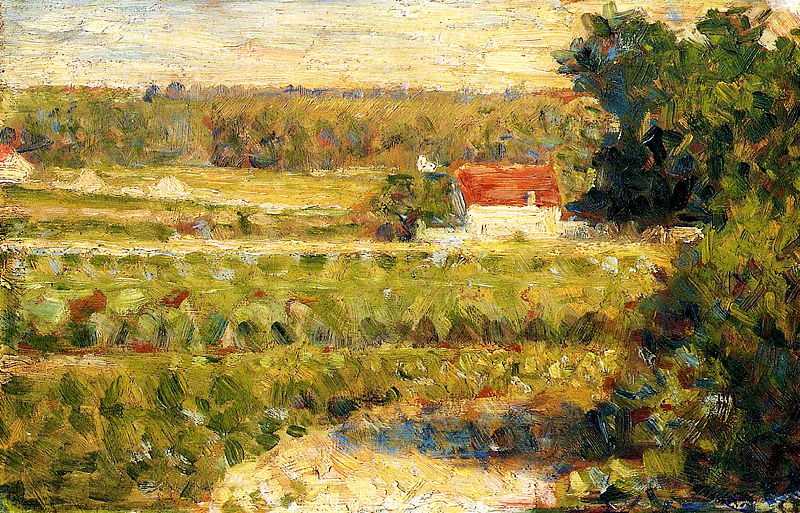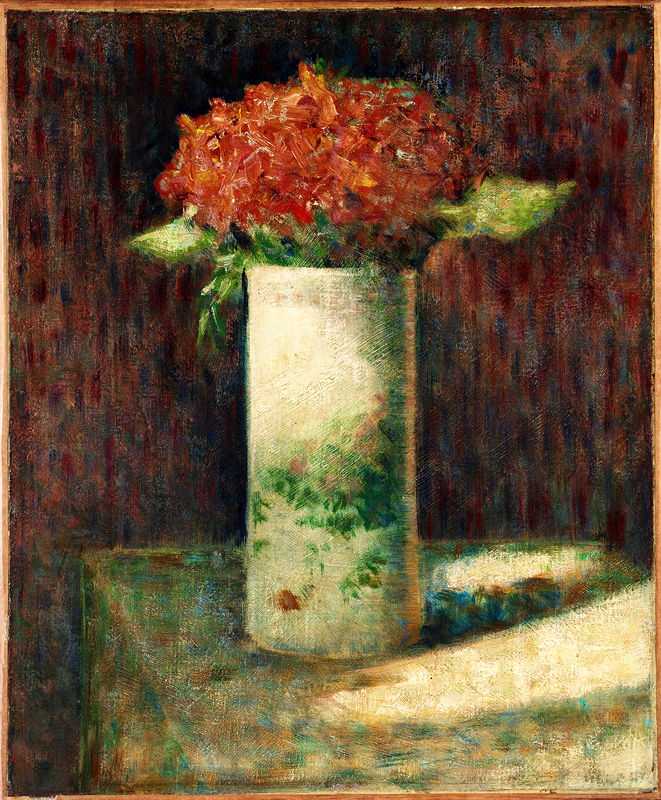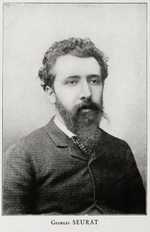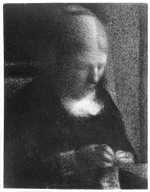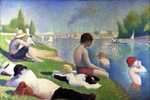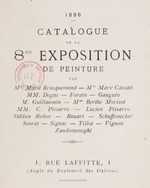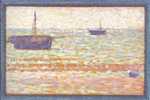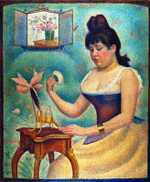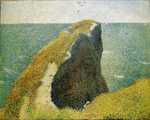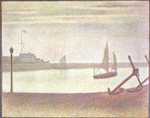1. Early Life
1859: Georges Seurat is born in Paris on the 2nd of December to a well-off family. His father Chrysostome-Antoine Seurat is a customs officer from the Champagne region of France, while his mother Ernestine Faivre is a Parisian woman from a wealthy family known for its skilled sculptors. Seurat, his sister Marie-Berthe, and his brother Émile live with their mother. Seurat's father lived away from his family, in Le Raincy, where he had retired after earning a small fortune, and visited his family in boulevard de Magenta once a week.
1862: Seurat’s family moves to 136 boulevard de Magenta.
1870: During the Franco-Prussian War and the following Paris Commune rebellion Seurat’s family temporarily shifts to Fontainebleau. Seurat’s interest in art is encouraged by his maternal uncle Paul Haumonté, a textile merchant and amateur painter who gives art lessons to Seurat.
2. Early Training
1875: Seurat’s first professional art training begins at a local institute close to his home, the École Municipale de Sculpture et Dessin, where he is taught by the sculptor Justin Lequien. He becomes friends with a fellow student Edmond Aman-Jean.
1878: Seurat along with his friend Aman-Jean, attends the famous École des Beaux-Arts where he is taught by Henri Lehmann. Lehmann is a disciple of the Neoclassical painter Jean-Auguste-Dominique Ingres and his teaching style is highly traditional and conservative. Consequently, for the most part, Seurat copies paintings by classical artists and sketches from casts of antique sculptures. He studies there for almost a year until November 1879.
1879: In April Seurat gets a chance to visit the fourth Impressionist exhibition and he becomes acquainted with the works of the impressionists. He is impressed by the works of Pissarro and Monet, the influences of which can be observed in his works later on. In November his training at Brest military academy begins. During his training, he keeps up with his art by sketching streetscapes, seascapes, boats, and portraits of his fellow trainees.
1880: After serving at Brest Academy for a year, he returns to Paris where he shares an apartment at 16 rue de Chabrol with two friends and rents a studio with Aman-Jean. For the next two years, he busies himself with studying and perfecting the techniques of monochrome painting. His painting of Ernestine Faivre, his mother, is also from this phase of his life. It is titled ‘Embroidery; The Artist's Mother’ and is created with Conté crayon completely in tones of black. It is one of the pieces he submits to the salon but it gets rejected.
1883: Seurat’s submission to the salon gets accepted for once. It is a sketch of Aman-Jean done in Conté crayon (which is a hard pencil composed of a mixture of charcoal or graphite with clay)
A big chunk of his year is spent painting the Bathers at Asnières, his first large-sized painting. He enriches his understanding of art by frequenting museums and libraries in the city. He also receives lessons from Pierre Puvis de Chavannes, an expert in allegorical classical paintings.
3. Mature Period
Seurat’s studies and experiments in color theory culminate in the Bathers at Asnières.
This painting is a defining moment in Seurat’s life, determining the path his art would take. This painting shows a group of lower-class workers relaxing by the river Seine, painted in a technique of crisscrossing brushstrokes and employing divisionism (later called pointillism) technique to some extent.
1883: Seurat sends the Bathers at Asnières to the Salon but his painting is rejected.
1884: Seurat and his artist friends form the Société des Artistes Indépendants. This allows him to display the Bathers at Asnières for public view. During this exhibition, he becomes friends with Paul Signac who is greatly impressed by Seurat's style.
He begins working on his next large-sized painting, Sunday Afternoon on the Island of La Grande Jatte. A lot of work goes into the painting as he visits the island of La Grande Jatte multiple times to make sketches for reference and the painting takes two years to finish.
1885: He added touches of chromo-luminarism - a term he used to describe the pointillist technique of applying dabs of contrasting colors in succession, which left the ‘mixing’ to the eye of the viewer - to his painting Sunday Afternoon on the Island of La Grande Jatte. He later does the same to the Bathers a couple of years later.
1886: Seurat displays Sunday Afternoon on the Island of La Grande Jatte at the Eighth and Final Impressionist Exhibition that takes place in May. The painting establishes Seurat as the leader of a new avant-garde movement. Although his works are presented at the impressionist exhibition, his style is so distinct from theirs that it is decided that his pieces should be displayed in another room.
4. Late Period
The exhibition of La Grande Jatte in the Final Impressionist Exhibition brings Seurat’s works to the focus of international audiences.
His art is talked about in art circles, reviews are written, and some pieces are displayed by Durand-Ruel galleries in Paris and New York City. In Paris, he begins mixing with a crowd of symbolist writers and artists which leads to his work achieving a duller color palette compared to the vibrant tones of his earlier works. This causes concerns for Signac and Pissarro as they felt he was leaving behind the scientific, pointillist approach to painting.
1885: Seurat’s pointillism evolves to incorporating broader brushstrokes with more spaces in between the spots of color. This creates an effect of brightness which can be observed in his work, L'échouage à Grandcamp (1885).
1886: Seurat spends time in Les Andelys with Signac who has become a close friend and the two artists work together on a collection of ten paintings.
1887: A brief period of military service in the summer of 1887 keeps him busy, as otherwise his summers in his later years are spent at seaside towns on the Normandy coast occupied with painting boats and seascapes.
1889: Seurat travels to Brussels, Belgium, to exhibit his work at the Salon des Vingt. He meets 20-year-old Madeleine Knobloch, who is a model and they have a secret affair.
1890: In February, Knobloch gives birth to a son. Seurat keeps this news hidden from his family and friends. At the Salon des Indépendants exhibition of the same year, Seurat displayed his portrait of Madeleine Knobloch called Young Woman Powdering Herself. It is his only known work portraying her.
1891: Madeleine Knobloch is expecting another child by the beginning of 1891, and Seurat is occupied with painting the Circus, his final painting that he would not be able to finish. On the 26th of March, Seurat suddenly becomes ill and he dies three days later. Only two days before his death he’d told his family about his son and Madeleine. Two weeks after his death, his son dies after catching the same illness and is buried alongside his father at the Père-Lachaise cemetery in Paris.
5. The Legacy of Georges Seurat
Seurat died at a very young age - he was only 31 - but despite that, he left behind an impressive collection of artworks including seven mural-sized paintings, several small ones, and hundreds of sketches and drawings. He was the pioneer in merging scientific ideas with art, and his work impacted several others in his circles. His style had a resounding effect and built the bridge between existing art forms and the radical new movements slowly coming into being such as cubism and fauvism.
1996: Seurat’s landscape titled "Le Chenal" sells for $2.7 million.
1999: Seurat's iconic painting "Island of the Grande Jatte" (1884) sells for an impressive $35.2 million at Sotheby’s auction in New York.

